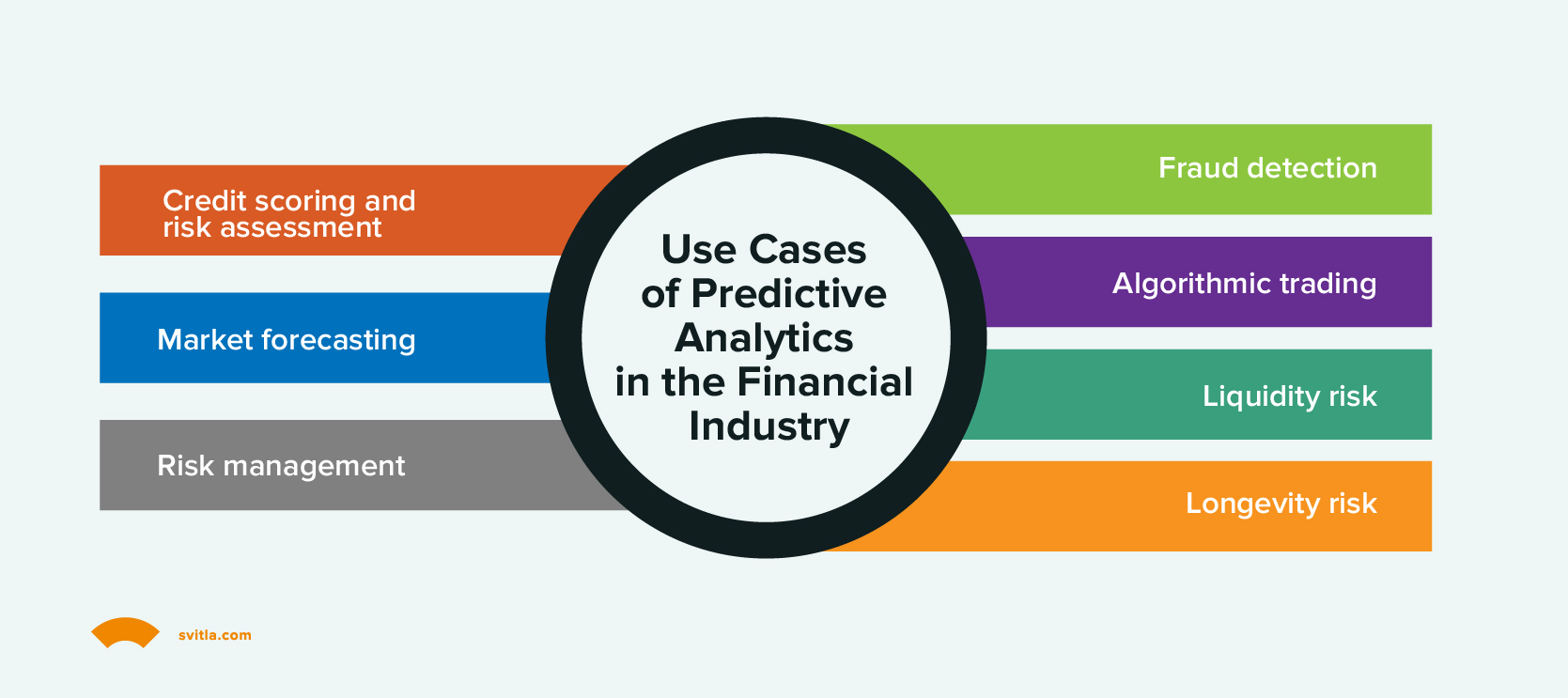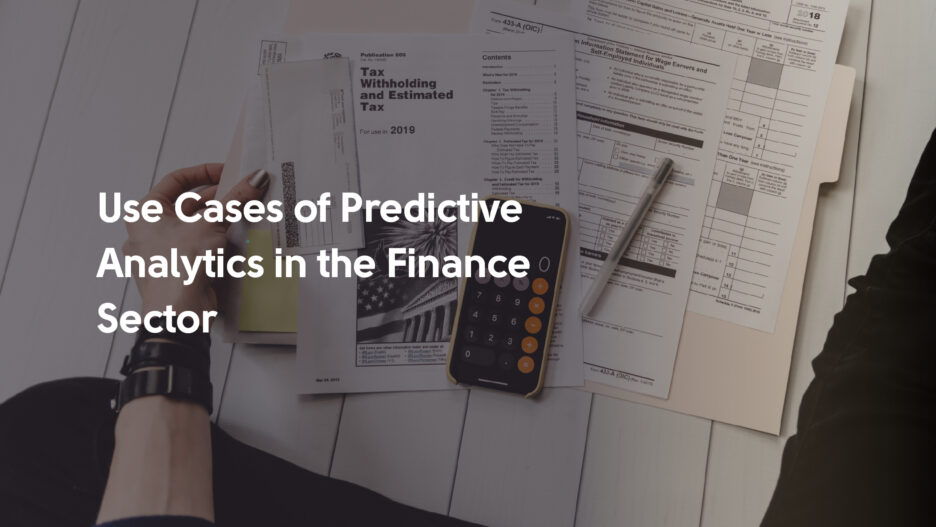Finance teams and CFOs are steered by a tidal wave of data in the modern financial landscape. As industries burgeon, so do their financial intricacies. With the increasing volumes of financial data, leaders in the sector face an urgent need to harness advanced data analytics solutions for crucial functions such as reporting, budgeting, and managing cash flows. However, the sheer magnitude of this data presents a dual challenge: not only to derive meaningful insights from it but also to manage and protect it diligently.
Predictive Analytics for Finance: Outlook
Predictive analytics is a powerful tool that equips finance professionals with the ability to anticipate market movements, optimize strategies, and make data-driven decisions with confidence. It's not just about looking at the numbers; it's about foreseeing where they might lead.
From making informed decisions during mergers and acquisitions to pinpointing the best moments for market expansion, and even to mastering the art of liquidity management, predictive analytics in finance is steadily revolutionizing the way the sector operates. With this advantage, finance leaders can navigate the challenges of the digital age, ensuring not only the profitability of their enterprises but also their resilience and adaptability.
Predictive Analytics Use Cases in Finance
The abundance of data in the finance sector, both in volume and variety, has opened up unprecedented opportunities for insights, strategy formulation, and decision-making. By diving deep into historical data, recognizing patterns, and projecting future trends, predictive analytics in finance offers a forward-looking lens, ensuring that financial institutions are not just reactive, but proactively poised for success.
The power of predictive analytics in finance extends far beyond mere number crunching. It's about leveraging data to craft narratives, anticipate market shifts, and drive strategic maneuvers with precision. Whether it's mitigating risks, spotting investment opportunities, or optimizing operations, the applications are vast and varied. In a sector where foresight can mean the difference between monumental success and unforeseen challenges, predictive analytics emerges as the linchpin, ensuring that financial entities are equipped to navigate the intricate and ever-evolving financial landscapes.
As we delve deeper into the predictive analytics use cases in finance in the following section, it becomes abundantly clear that this isn't just another technological trend. It's a paradigm shift that promises a new era of innovation, efficiency, and robust growth for the finance industry.
1. Credit scoring and risk assessment
One of the most transformative applications of predictive analytics in finance lies in credit scoring and risk assessment. Traditionally, credit scoring relied heavily on historical data — past behavior, outstanding debts, and payment records. While these metrics remain foundational, predictive analytics introduces a broader array of variables into the equation, offering a more holistic view of a borrower's creditworthiness.
Predictive models are now equipped to analyze non-traditional data sources, like utility payments, social media activity, and even purchasing habits. Such insights provide a multi-dimensional perspective on a borrower's financial behavior and potential future actions. For instance, a consistent record of timely utility payments might hint at a borrower's reliability even if they lack a conventional credit history. Conversely, sudden changes in online behavior or purchasing patterns could be indicative of financial strain or upcoming instability.
Moreover, the dynamic nature of predictive analytics in finance means that credit scores can be updated in near-real-time, reflecting the most current data available. This real-time evaluation not only benefits lenders by reducing the risk of bad loans but also empowers borrowers. They get a fairer assessment, potentially leading to better loan terms and interest rates. In the larger scheme of things, with accurate credit scoring and risk assessment through predictive analytics, the finance sector can achieve a balance between fostering growth and maintaining security.
2. Fraud detection
By continuously monitoring and analyzing vast amounts of transactional data, predictive models can discern patterns and anomalies that might elude even the most astute human eye. These models are trained on diverse sets of transactional data, learning from both legitimate and suspicious activities. With this knowledge, they can predict and flag potential fraudulent activities in real-time. For instance, if a user's credit card suddenly registers transactions in a country they've never visited, or if there's an uncharacteristic surge in account transfers, the system can send immediate alerts. This rapid response capability not only helps in immediate threat mitigation but also deters future fraudulent attempts by making the financial systems more formidable against breaches.
The beauty of predictive analytics in fraud detection lies in its adaptability. As fraudsters evolve and employ new tactics, the models, fed with the latest data, learn and adapt, ensuring that the finance sector remains one step ahead in this ongoing game of cat and mouse.
3. Market forecasting
The ability to anticipate market trends is invaluable in the finance sector. Market forecasting typically blends economic indicators with intuition, and it’s entering a new era with the aid of predictive analytics. By sifting through colossal datasets – from stock prices and global economic indicators to social media sentiments and geopolitical events – predictive models provide a more comprehensive outlook on potential market movements.
Predictive analytics identifies patterns, gauges investor sentiment, and even anticipates the ripple effects of events in related markets. Imagine the power of forecasting tools that could have, in the past, foreseen the global financial implications of local events, be they political upheavals, technological breakthroughs, or natural disasters. In real-time, traders and investors can receive insights, allowing them to make informed decisions, hedge risks, or identify golden investment opportunities.
However, as with all tools, the efficacy of predictive analytics in market forecasting depends on the quality and diversity of data it processes and the sophistication of the models used. Nevertheless, its potential is undeniable. In the hands of experts, predictive analytics for finance serves as both a compass and a map, charting out the murky waters of future market landscapes.
4. Algorithmic trading
Algorithmic trading involves executing large orders of trades at lightning speeds, using advanced mathematical models to make decisions based on a myriad of variables. At its heart, it's the embodiment of predictive analytics in finance applied to real-time decisions.
These algorithms leverage predictive models to identify fleeting patterns and opportunities in the market, ones that might be invisible or too transient for human traders to exploit. From analyzing minute changes in stock prices to tracking global news in real-time, these algorithms can execute trades in fractions of a second, capitalizing on narrow windows of opportunity. Such trades, though minute in individual profit margins, can accumulate significant returns when executed at scale.
However, the immense power of algorithmic trading also necessitates stringent oversight and robust risk management practices. Unchecked, a malfunctioning algorithm or one based on flawed models can lead to substantial financial losses or even broader market disruptions. But, when wielded with precision and care, algorithmic trading, driven by predictive analytics, stands as a testament to the astonishing potential of technology in reshaping the financial sector.
5. Risk management (identifying, measuring, and mitigating risks in investment portfolios)
Predictive analytics for finance has emerged as a pivotal tool in risk management in portfolio strategy. By employing sophisticated algorithms and models, it delves deep into data, offering a granular view of potential vulnerabilities within an investment portfolio.
Predictive models dive into historical data to uncover patterns and correlations between various assets. They factor in variables such as market volatility, geopolitical events, interest rate shifts, and even macroeconomic indicators, providing a holistic risk profile of a portfolio. By doing so, these models can anticipate scenarios where assets might underperform or where market conditions might adversely impact a portfolio's value. For example, if certain stocks in a portfolio consistently underperform during specific economic downturns, predictive analytics can highlight this trend, enabling investors to reconsider their allocations.
But the real strength of predictive analytics in risk management lies in its proactive nature. Instead of merely reacting to market downturns or unexpected events, financial professionals can use these insights to devise strategies that preemptively shield portfolios from potential turbulence. Through scenario analysis, stress testing, and other predictive techniques, investors can explore a vast landscape of possibilities and adjust their strategies accordingly, ensuring that their portfolios remain resilient, even in the face of uncertainty.
6. Liquidity risk
At its core, liquidity risk revolves around an institution's ability to meet its short-term financial obligations, primarily redemption requests from clients. The real danger arises when these redemptions, if not adequately managed, lead to significant disruptions, forcing the sale of assets at suboptimal prices or even precipitating a broader market panic.
In this complex environment, predictive analytics offers a lifeline. Risk analytics and modeling software delve into vast datasets to simulate various scenarios, allowing firms to anticipate potential liquidity crunches and prepare accordingly. This proactive approach provides a roadmap for institutions, outlining strategies to ensure that sufficient liquid assets are on hand to meet demands without resorting to distress sales.
Complementing this, liquidity risk measurement and reporting software enables firms to maintain a real-time view of their liquidity positions, ensuring that they remain compliant with regulatory standards and are prepared for any sudden market shifts.
Lastly, data analytics and Business Intelligence (BI) software integrate various data sources, offering a holistic view of market conditions, asset performance, and client behavior, which can further refine a firm's understanding of its liquidity risk profile.
Harnessing the power of predictive analytics, investment firms can navigate the intricacies of liquidity risk, ensuring that they remain both responsive to client needs and resilient in the face of market volatility.
7. Longevity risk
The inexorable march of time brings with it many uncertainties, especially in the realm of wealth management. One of the most pressing concerns for financial advisors and their clients is longevity risk — the unsettling prospect of outliving one's savings. As life expectancies rise and retirement landscapes evolve, addressing this risk becomes paramount. The challenge lies in striking a balance between ensuring clients can maintain their desired lifestyle throughout retirement without depleting their financial resources prematurely.
Armed with data analytics and advanced predictive modeling, wealth managers can gain profound insights into demographic trends and the subsequent impact of increasing longevity on their client base. By analyzing patterns in life expectancy, health advancements, economic factors, and even lifestyle choices, these tools can create comprehensive projections of a client's financial needs well into their twilight years. Such insights enable advisors to tailor investment strategies, ensuring that portfolios are structured to generate sustainable returns and income streams, even if clients live significantly longer than traditional retirement planning models might anticipate.
By leveraging the power of predictive analytics, wealth management professionals can proactively address longevity risk, offering their clients not just financial strategies, but peace of mind. In a world where living longer is becoming the norm, ensuring that those extra years are spent in financial security and comfort is a goal that predictive analytics is uniquely poised to achieve.

Embracing the Future of Predictive Analytics for Finance with Svitla Systems
Predictive analytics stands as a beacon in the dynamic finance sector, where uncertainties abound and the stakes are high. It guides institutions through today's complexity and reveals tomorrow's opportunities.
The key to unlocking the full potential of predictive analytics lies not just in its adoption, but in its tailored application to suit the unique challenges and aspirations of each entity.
When it comes to stepping confidently into the future, Svitla Systems is an expert you can trust. With a proven track record in predictive analytics solutions, Svitla Systems doesn't offer a one-size-fits-all solution, but rather a bespoke strategy designed around your specific needs.
Partner with Svitla Systems to search, strategize, and implement the predictive analytics solutions to ensure your financial endeavors are successful.




![[Blog cover] SEO optimization best practices](https://svitla.com/wp-content/uploads/2025/05/Blog-cover-SEO-optimization-best-practices-560x310.jpg)
